

Un soir, un musée, un verre spécial "Les Maîtres du désordre" (with images, tweets) · quaibranly. Les logiques participatives en muséologie aujourd’hui «DASM DASM. Réflexions sur le principe du livetweet d’exposition. Visitor Voices: Cacophony or Chorus? Thoughts on NEMA 2012. I just breezed out of beautiful Burlington, Vermont as the 2012 NEMA (New England Museum Association) wrapped up for another year.

My big takeaway centered on all the session (and hallway!) Chatter involving the issues and challenges regarding the increasingly greater inclusion of visitor input into museum exhibits and programs. Certainly fostering cultural organizations that are more responsive to, and inclusive of, the many different communities that interact with each museum is important, but I was struck by an odd little nuance during many of the conversations in Burlington.
Museums in the era of participatory culture. The Gallery of Lost Art, Tate Gallery In May this year, the Centre de Cultura Contemporània de Barcelona hosted the 2012 MuseumNext Conference , an industry event on the future of museums, new forms of participation and exhibition, and the latest technological innovations being developed in the museum field. On 3 October, a similar event was held in London under the title “ Musem Ideas ”, where experts discussed the culture of participation. The conference featured seven presentations by a series of experts from the field of museums in the English-speaking world. Each speaker talked about their recent projects and their current vision of the future of museums. This text summarises some of their ideas. “What role does the museum play in our society?” À la recherche de la muséologie participative : jalons historiques, enjeux et tensions. - Quelque part en thèse.
I went to MoMA and... Museums and the Web 2008: Paper: Salgado, M., Breaking Apart Participation in Museums. As part of my research I was involved in producing concepts and prototypes that delve deeply into participation.
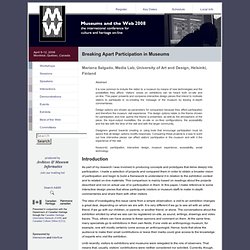
I made a selection of projects and compared them in order to obtain a broader vision of participation and begin to build a framework to understand it in relation to the exhibition context and to related on-line materials. This comparison is mainly based on readings about the projects described and not on actual use of or participation in them. In this paper, I make reference to some interactive design pieces that allow participants (visitors or museum staff) to make in-depth commentaries and share them with other visitors.
The idea of investigating this issue came from a simple observation: a visit to an exhibition changes a great deal, depending on whom we are with. It is very different if we go to see art with an artist friend, if we go with our children, or parents, or another friend, or alone. Certain design decisions are key to participation. The parameters are: Participatory Engagement in Museums. 17 Ways We Made our Exhibition Participatory. Going to MAH and seeing the LOVE exhibition on First Friday was a wonderful experience.
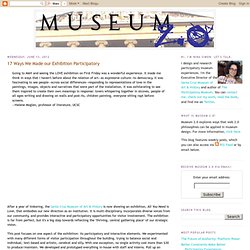
It made me think in ways that I haven't before about the relation of art--as expressive culture--to democracy. It was fascinating to see people--across social differences--responding to representations of love in the paintings, images, objects and narratives that were part of the installation. It was exhilarating to see them inspired to create their own meanings in response: lovers whispering together in alcoves, people of all ages writing and drawing on walls and post-its, children painting, everyone sitting rapt before screens.
--Helene Moglen, professor of literature, UCSC After a year of tinkering, the Santa Cruz Museum of Art & History is now showing an exhibition, All You Need is Love, that embodies our new direction as an institution. Utilizing YouTube Quick Capture for Community Voices. The Black List Project just opened last week and our education staff really wanted to include visitor response as part of the exhibition.
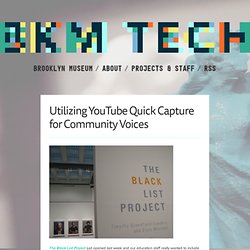
Typically, we do this with our electronic comment books which have been working well for us, but the educators felt that a more personal storytelling was what they were looking for with this show and incorporating video would help fulfill those needs. The original idea was to set up recording times and take quick video responses in the gallery, but knowing how much editing work would come our way…my response was a very fast and very frustrated “we can’t possibly take this on.”
We started thinking about self-service video kiosks, but quickly found engineering a custom solution was going to drain too much staff time and products for purchase were insanely expensive, so no go. Argh! …well, we found a way and it’s simple enough that anyone can do it. Now that we’ve got these working, we are all a little curious to see what in the world happens. Réflexions sur le principe du livetweet d’exposition.
Twitter et les musées….oui ou non ? et pourquoi ?! Reviews of The Participatory Museum – The Participatory Museum. Guest Post: Using Visitor Participation to Improve Object Labels at the San Diego Natural History Museum. Our problem is this.

We have 2500 square feet of exhibit space destined to become a “core” (i.e., essentially permanent) exhibition on collections-based research. We have no funding and a staff that is stretched with temporary exhibitions, contracts, and other long-term planning. Add to this an administrative directive to “put more natural history objects on the floor” and a general lack of the front-end evaluation that would help staff understand the interests, preconceptions, and expectations visitors bring to the topic of collections and research in natural history museums. To date, the solution has been to put photos on the walls, pray for funding, and ignore the front-end evaluation bit. But when customers start shouting down the stairs to their friends and family, “Don’t come up here! The premise of “Case by Case” is pretty simple: put objects on display with no label and provide the visitor with an opportunity to ask questions and/or make observations about the objects.
Le musée participatif (3/3) : synthèse et bibliographie « DASM. Suite et fin de mon projet de recherche avec la synthèse de la problématique et quelques orientations bibliographiques.
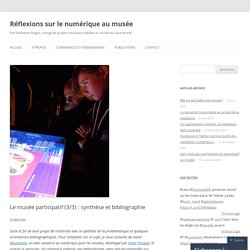
Pour compléter sur le sujet, je vous conseille de visiter Muzeonum, un wiki consacré au numérique pour les musées, développé par Omer Pesquer et auquel je participe. Le musée participatif (2/3) : quelques initiatives. Après Le musée participatif : état des lieux, voici la suite de la note d’intention de mon projet de thèse, avec quelques exemples existants.
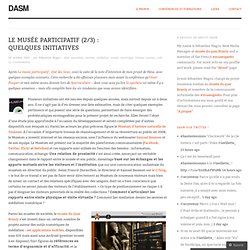
Cette recherche a été effectuée plusieurs mois avant la conférence qu’Omer Pesquer et moi-même avons donnée lors de Spectaculaire – dont vous avez pu lire la synthèse ici même il y a quelques semaines – mais elle complète bien les six tendances que nous avions identifiées. Musées et numérique : le faux réajustement de l’offre culturelle ? Cet article est une réaction à une conférence de la Social Media Week Paris 2012, « Musées et numérique : le visiteur 2.0 », à l’Auditorium du Petit Palais, mercredi 15 février.
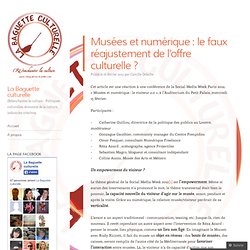
Participants : - Catherine Guillou, directrice de la politique des publics au Louvre, modérateur- Gonzague Gauthier, community manager du Centre Pompidou - Omer Pesquer, consultant Numérique Freelance - Réza Azard , scénographe, agence Projectiles - Sebastien Magro, blogueur et consultant indépendant - Coline Aunis, Musée des Arts et Métiers.
Le musée participatif : état des lieux. En raison de mes engagements pour l’année universitaire 2011-12, j’ai du renoncer au projet de commencer une thèse en muséologie.
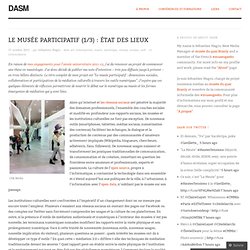
J’ai donc décidé de publier ma note d’intention – très peu diffusée jusqu’à présent – en trois billets distincts. Le titre complet de mon projet est "Le musée participatif : dimensions sociales, collaboratives et participatives de la médiation culturelle à travers les outils numériques". J’espère que ces quelques éléments de réflexion permettront de nourrir le débat sur le numérique au musée et les formes émergentes de médiation qui y sont liées. CFA Berlin.